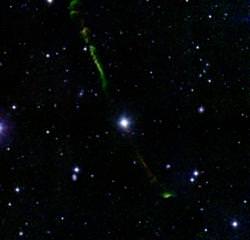Newly forming planetary systems follow a routine. They collapse down from a cloud of gas and dust to form a central star and orbiting planets. But astronomers have found two unusual stars that went through a second phase of planetary formation, hundreds of millions or even billions of years after the first.
The announcement was made by Carl Melis, an astronomy graduate student at UCLA, at the 211th meeting of the American Astronomical Society held in Austin, Texas.
“This is a new class of stars, ones that display conditions now ripe for formation of a second generation of planets, long long after the stars themselves formed,” Melis said.
The two bizarre stars are known as BP Piscium, in the constellation Pisces, and TYCHO 4144 329 2, in the constellation Ursa Major. They have characteristics similar to young stars, such as the rapid accretion of gas, extended disks of material, infrared emissions of radiation, and even jets.
They may act young, but these stars are very old. The astronomers measured the quantities of lithium in the stars; an element which is consumed when stars get older. If they were young, they would still have their reserves of lithium, but they have very little of it left.
So you have older stars behaving like young stars; what happened?
The researchers think that these stars were once part of a binary system where a solar-mass star was matched with a much less massive star. The more massive star ran out of fuel first and ballooned up as a red giant, engulfing the smaller star. At this point, the smaller star would actually be orbiting inside the envelope of the red giant, forcing material out into space, while slowly spiraling inward to meet its destruction.
This ejected material would actually contain the building blocks of terrestrial planets, and so, the planetary formation process would get going all over again. The size of the new planets that could form would depend on how much material was ejected during this red giant phase.
Original Source: UCLA News Release


Well well well, Genesis Continuous, you’re getting closer.
How many contradictions and ad-hoc postulates can the standard accretion theory withstand? There is very little predictive capabilty in the standard picture and that should give serious pause.
Everyone should re-read “The Physics of Immortality” and pay attention to the math regarding the estimable life of the universe. We should be proud and exhilirated to discover that we are in the early childhood of this marvelous universe.
To ‘pretend’ to quote ‘Spock’, … It is logical
My own take on it, … was there a question about it in the first place in regard to ‘Binaries’ ?
Some people think that our Sun is one of these stars…